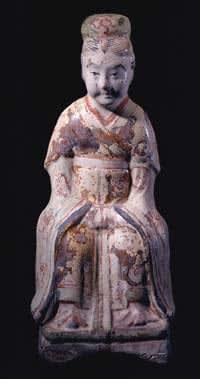Tang Sculpture of a Seated Lady, 618 CE - 907 CE
Terracotta
8.25
H.047a
Seated with legs slightly apart and arms resting on lap, this female figurine depicts an aristocratic lady. Her delicate features and plump face convey the ideal image of feminine beauty,...
Seated with legs slightly apart and arms resting on lap, this female figurine depicts an aristocratic lady. Her delicate features and plump face convey the ideal image of feminine beauty, as her posture on a seated throne relate to her privileged position among women of the inner chambers. She wears elaborately designed clothing consisting of several layers of intricately decorated silk robes in floral motif. The various borders, hems, cuffs and collars are delineated in colors of white, red, green and yellow, and the designs are primarily painted on, except for a few incised lines and folds on the outer robe. The woman clasps a sash in her hands which hangs between cloud toe tipped shoes. Her face is whitened, delicately modeled in the cheek, mouth, nose and eye area which is pronounced with rose and black pigment. Her hair is combed into a bun, surmounted by a small, puffy cap decorated in matching floral motif. Burial art of the T'ang period is characterized by a penchant toward figural objects rather than architectural models that prevailed during the Han. Princes and officials often commissioned large, brilliantly glazed sets of ceramic figures which ushered in the mass production of burial objects. However, the desire to imbue figurines with a life-like quality kept artisans busy creating Buddhist guardians, court entourage, civil and military officials and other figures.



